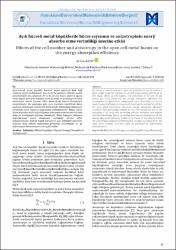| dc.contributor.author | Kaya, Ali Can | |
| dc.date.accessioned | 2021-01-08T21:51:21Z | |
| dc.date.available | 2021-01-08T21:51:21Z | |
| dc.date.issued | 2020 | |
| dc.identifier.issn | 1300-7009 | |
| dc.identifier.issn | 2147-5881 | |
| dc.identifier.uri | http://doi.org/10.5505/pajes.2019.53810 | |
| dc.identifier.uri | https://hdl.handle.net/20.500.12846/172 | |
| dc.description | Kaya, Ali Can/0000-0003-2856-5508 | en_US |
| dc.description | WOS:000514814600006 | en_US |
| dc.description.abstract | By means of cellular structure, open cell metal foams can be used as a light-weight material, and they can absorb impact energy effectively. In this study, effects of cell number and anisotropy in 30 and 45 ppi (pores per inch) foams on the energy absorption efficiency are investigated by quasi-static compression tests. According to current study, strength of foams decreases with lowering the number of cells for the same foam dimensions. However, energy absorption efficiency increases with decreasing number of cells. The reason for this is the enlarging of cell voids with increasing cell size; therefore, cells deform with less hardening. Effects of loading direction of metal foams on the energy absorption efficiency could not be found. It was observed that the cuboid foam samples exhibited larger strength as compared to the cubic foam samples, and this could be expressed by deformation concentrations. | en_US |
| dc.language.iso | tur | en_US |
| dc.publisher | Pamukkale Univ | en_US |
| dc.rights | info:eu-repo/semantics/openAccess | en_US |
| dc.subject | Metal Foams | en_US |
| dc.subject | Compression Testing | en_US |
| dc.subject | Efficiency | en_US |
| dc.subject | Hardening | en_US |
| dc.title | Effects of the cell number and anisotropy in the open cell metal foams on the energy absorption efficiency | en_US |
| dc.type | article | en_US |
| dc.relation.journal | Pamukkale University Journal Of Engineering Sciences-Pamukkale Universitesi Muhendislik Bilimleri Dergisi | en_US |
| dc.identifier.volume | 26 | en_US |
| dc.identifier.issue | 1 | en_US |
| dc.relation.publicationcategory | Makale - Uluslararası Hakemli Dergi - Kurum Öğretim Elemanı | en_US |
| dc.contributor.department | TAÜ, Mühendislik Fakültesi, Mekatronik Mühendisliği Bölümü | en_US |
| dc.contributor.institutionauthor | Kaya, Ali Can | |
| dc.identifier.doi | 10.5505/pajes.2019.53810 | |
| dc.identifier.startpage | 45 | en_US |
| dc.identifier.endpage | 50 | en_US |
| dc.identifier.wosquality | N/A | en_US |

















